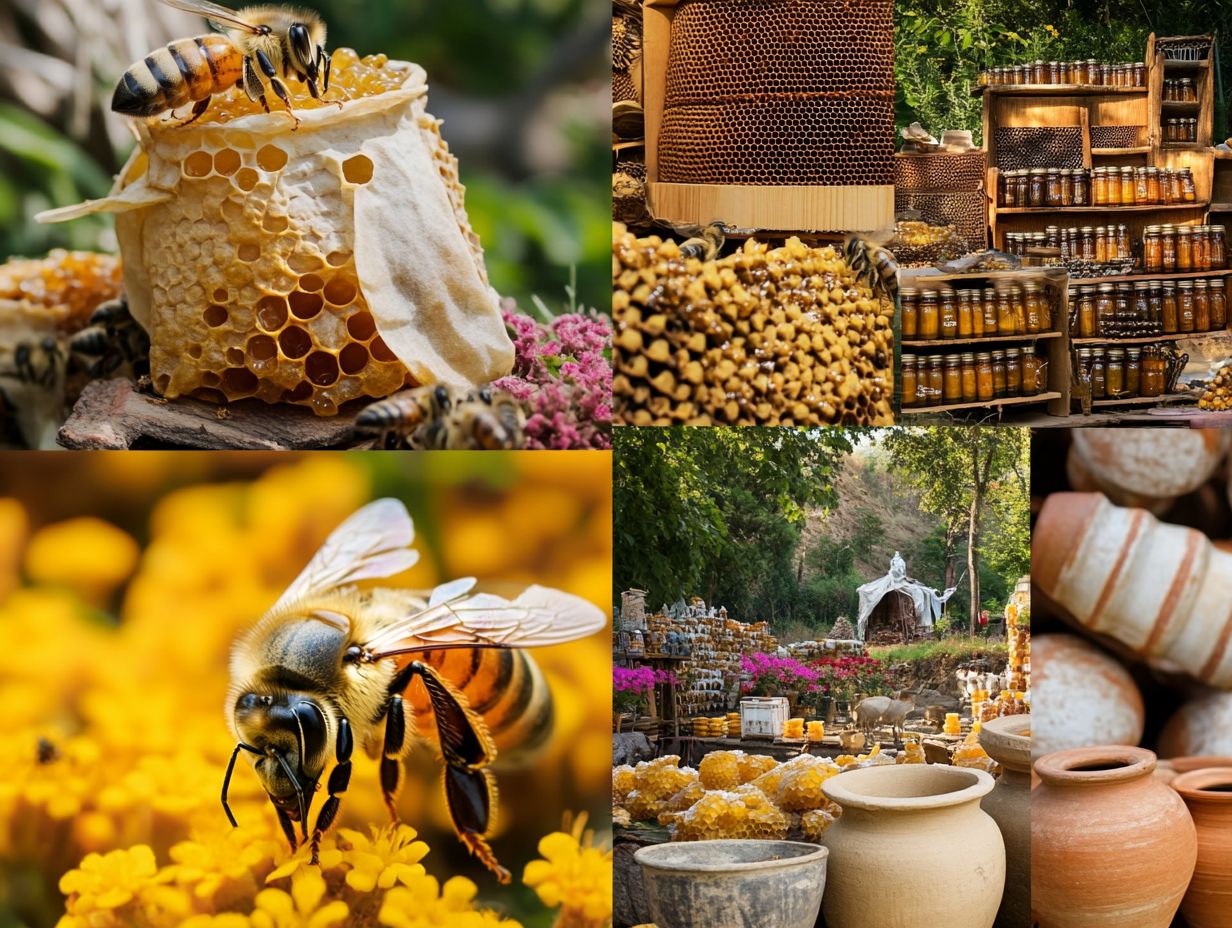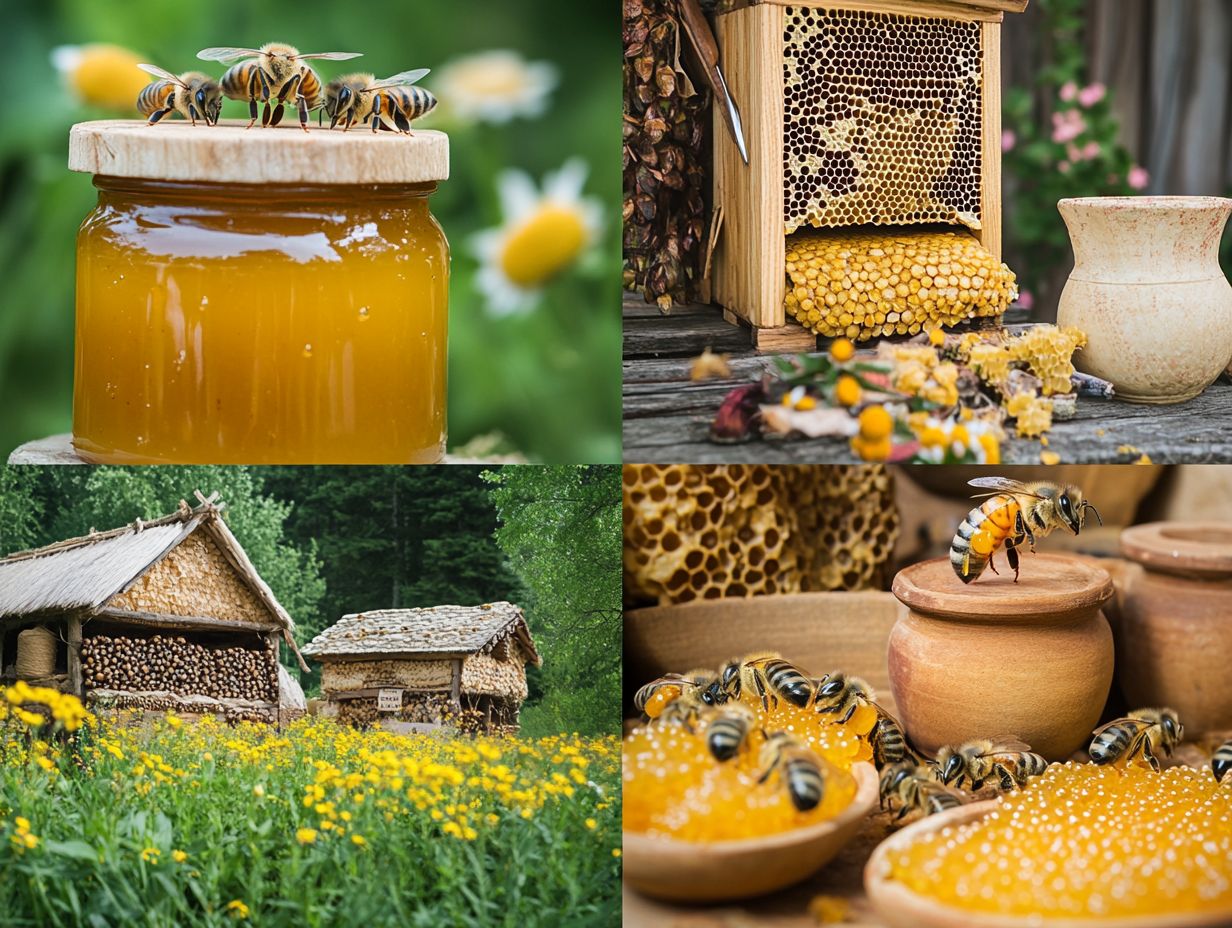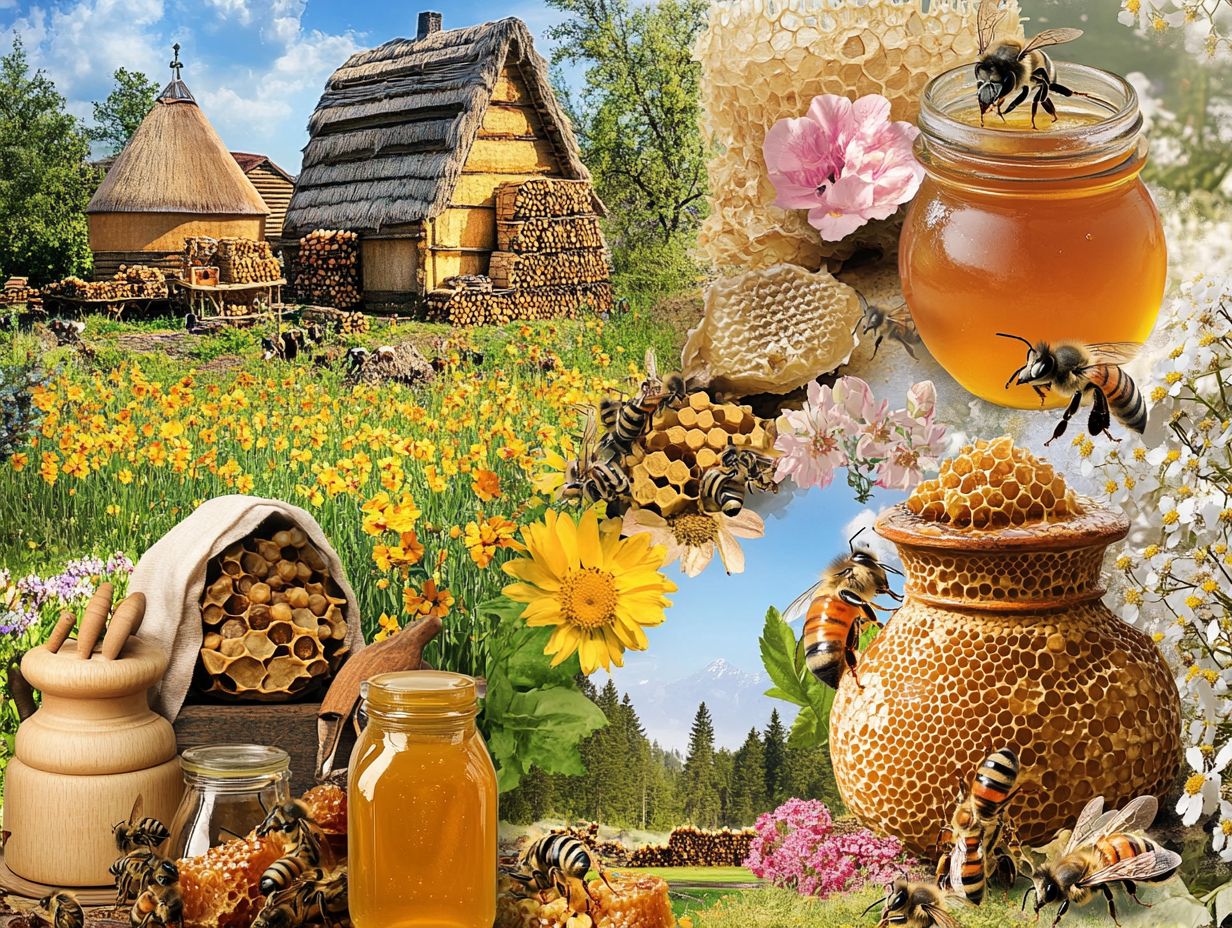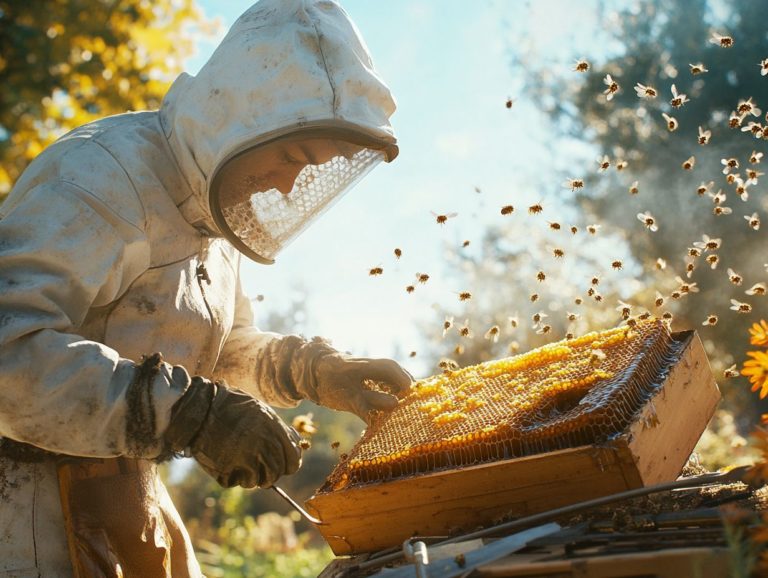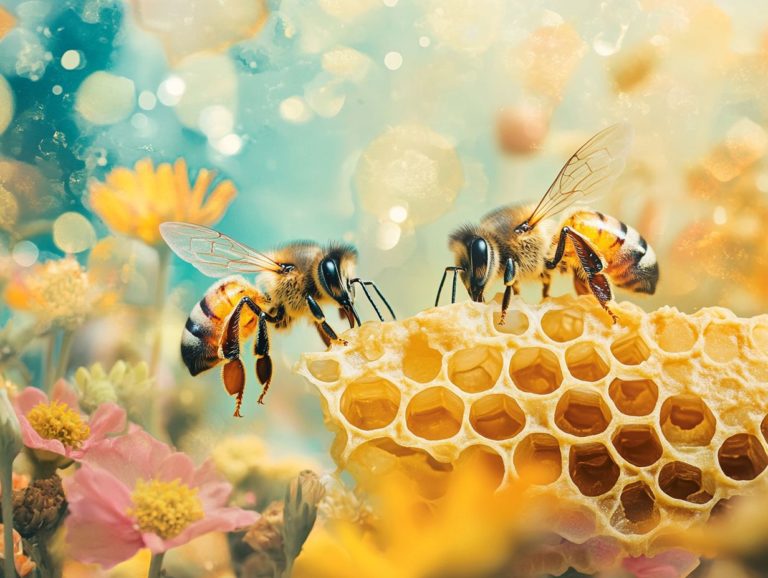The History of Honey Production Around the World
Honey is famous for its sweetness and versatility. Its rich history stretches back to ancient civilizations.
From foraging for wild honey to the beekeeping practices of the Middle Ages, honey production is intertwined with human culture and agriculture.
This exploration will take you through the evolution of honey production. You’ll learn about its significance across different eras and cultures, including the traditions of honey gathering and the impact of industrialization.
You will also discover the challenges producers face today, like the Varroa destructor mite. Innovative approaches are being developed to secure honey’s future, so get ready to dive into the sweet story behind this age-old treasure.
Contents
Key Takeaways:
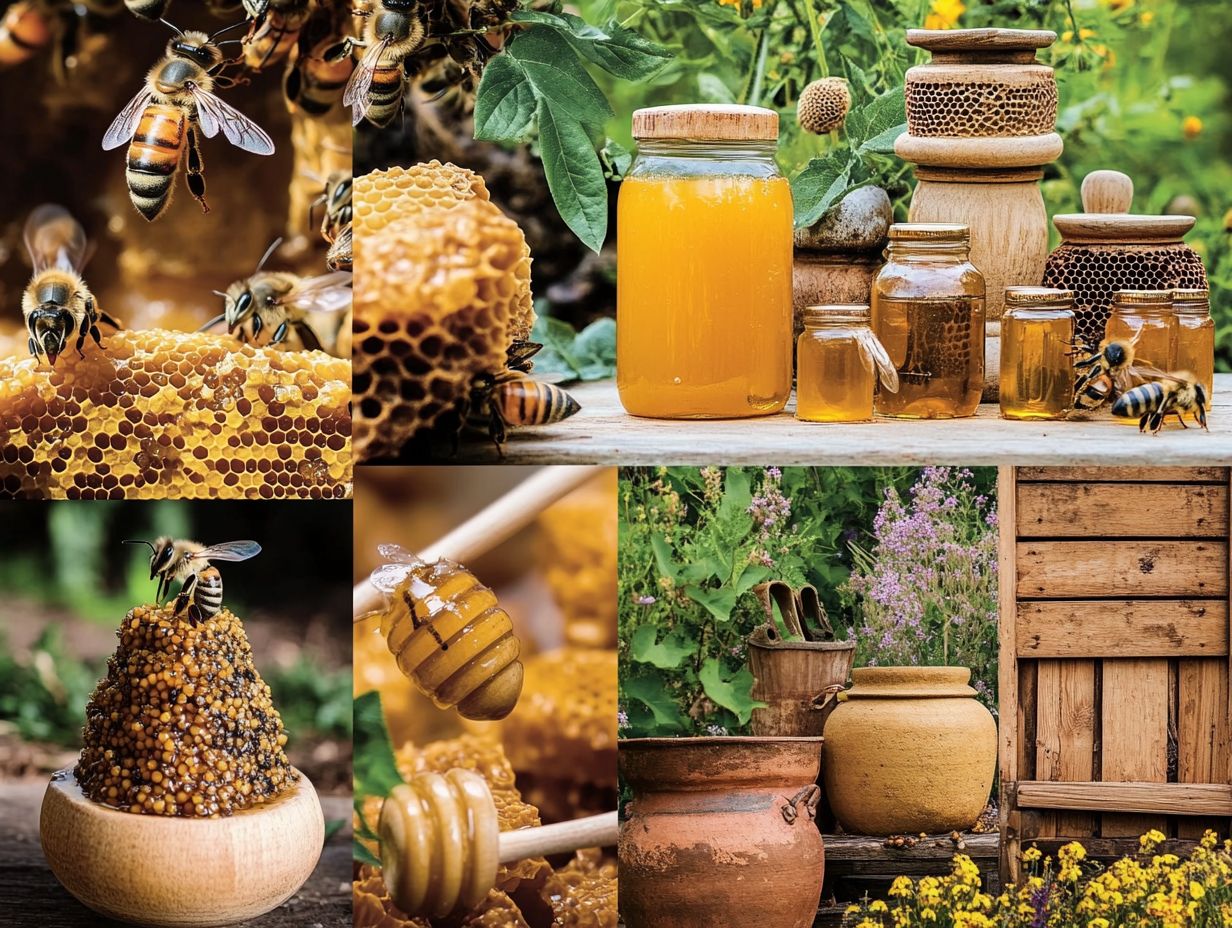
- Honey production has a long history, dating back to ancient civilizations like Mesopotamia, Egypt, and Greece.
- The Middle Ages saw the growth of beekeeping guilds and the role of monasteries in honey production.
- Modern beekeeping practices and industrialization have greatly impacted the global honey industry.
The Origins of Honey Production
The origins of honey production date back thousands of years. Evidence shows that ancient civilizations, like the Ancient Egyptians, were harvesting honey as early as 3000 BC.
These early beekeepers utilized a type of honeybee known for its ability to produce various kinds of honey. They used techniques like honeycomb harvesting to enjoy the natural sweetness and gain the benefits of honey as both food and medicine.
Early Honey Production in Ancient Civilizations
In ancient cultures, honey was treasured and often sourced from wild beehives. It was woven into daily life.
The Egyptians didn’t just use honey as a sweetener; they valued its medicinal properties. It was used in embalming rituals and offered to the gods, showcasing its sacred status.
The Mayans embraced honey as a cultural staple. They incorporated it into traditional beverages like pulque and various dishes, recognizing its ability to enhance flavors and its natural healing qualities.
This rich history of honey resonates today, reminding us of its enduring significance.
The Role of Honey in Ancient Cultures
In ancient cultures, honey played a vital role in daily life and rituals. The Ancient Egyptians celebrated its health benefits and delightful sweetness.
In the ancient Mayan civilization, honey was an important part of ceremonies and symbolized fertility and abundance. They used it for medicinal purposes and in their culinary traditions.
Honey also played a key role in making mead, a fermented drink popular among cultures like the Greeks and Romans. It connected the earthly and divine, highlighting its significance beyond mere nourishment.
Honey Production in the Middle Ages
During the Middle Ages, honey production experienced a resurgence. Monasteries became centers of beekeeping expertise and used innovative methods for honey preservation.
This new focus enabled the systematic cultivation of honey and led to the creation of unique honey varieties like Clover Honey and Wildflower Honey.
The Rise of Beekeeping Guilds
The rise of beekeeping guilds during the Middle Ages represents a significant turning point in honey production, setting rules for how to collect nectar and standards that you, as a beekeeper, would employ.
These guilds introduced rules to ensure quality control and improve harvesting techniques. This led to a notable increase in productivity.
By fostering a structured approach to beekeeping, you would benefit from shared knowledge on optimal seasonal practices and new tools.
This collaboration resulted in a diverse array of honey varieties, each reflecting the unique flora of its region, capturing the attention of local markets. The economic impact of these guilds is profound; they not only provided a stable income for their members but also cultivated a sense of community, allowing local economies to thrive through enhanced trade and collaboration among beekeepers.
The Role of Monasteries in Honey Production
Monasteries were pivotal in the honey production landscape during the Middle Ages, serving as not just beekeeping hubs but also as stewards of honey’s rich history and practices.
These monastic communities diligently honed their beekeeping techniques, ensuring that invaluable knowledge was preserved across generations. They produced honey not only for their own consumption but also crafted unique varieties that showcased the local flora, often employing traditional methods to harvest and process their sweet yields.
This expertise significantly influenced local economies, as their honey became a highly sought-after commodity for trade and medicinal uses. Monks meticulously recorded their observations in beautifully crafted manuscripts, detailing the benefits of various honeys and elevating this natural product’s status in both religious and secular circles.
These communities committed to their craft and linked honey production with spirituality, leaving behind a legacy of beekeeping knowledge that would inspire future generations.
Honey Production in the Modern Era
The modern era of honey production is marked by remarkable advancements in beekeeping techniques and an enriched understanding of honey fermentation. However, this period is not without its challenges, notably the persistent threat posed by the Varroa destructor mite, a harmful pest that affects bee health, which endangers honey bee populations worldwide.
The Development of Modern Beekeeping Techniques
The evolution of modern beekeeping techniques has transformed honey production, introducing innovative methods that enhance both the health of honey bees and the yield of honey, including strategies to combat pests like the Varroa destructor.
You’ll find that these advancements encompass sophisticated hive management practices utilizing monitoring technology to keep tabs on bee activity and hive conditions, ultimately fostering healthier colonies.
Effective pest control strategies have also been adopted, equipping you to tackle threats like Varroa mites while keeping chemical interventions to a minimum. Breeding practices aimed at developing disease-resistant bee strains further bolster sustainable honey production.
Together, these techniques not only boost the quantity of honey harvested but also elevate its quality, leading to honey that bursts with flavor and is packed with beneficial properties.
The Impact of Industrialization on Honey Production
Industrialization has dramatically reshaped honey production, steering it towards mass production and a wider array of honey varieties.
This shift helps you scale operations and increase efficiency by leveraging advanced technologies and mechanization. While these innovations make honey more accessible and lower costs for consumers, they also bring forth critical quality concerns.
Artisanal beekeeping methods, which often prioritize volume, can overshadow the unique flavors and health benefits that come with traditionally produced honey. As you navigate the marketplace, understanding the implications of these industrial processes becomes essential.
The delicate balance between quantity and quality directly influences the health benefits honey offers, prompting you to be more discerning in your choices. Now is the time to understand the effects of industrialization on honey quality!
The Global Honey Industry Today
Today, you’ll find that the global honey industry is a rich and intricate market. It showcases an impressive array of honey varieties sourced from many key producing countries, including Valencia, Spain.
Each variety boasts its own distinct flavors and notable health benefits of honey. Explore the delightful complexity of this natural treasure!
Major Honey Producing Countries
Major honey-producing countries like China, the United States, and Argentina dominate the global honey market. They each offer distinctive types such as Clover Honey and Wildflower Honey, showcasing the diversity found in Almond groves and other regions.
These nations use various production methods tailored to their unique climates and flora. For instance, as the world’s largest honey producer, China employs large-scale commercial beekeeping practices. It is renowned for its versatile honey varieties, including acacia and buckwheat.
The United States focuses on environmentally friendly methods, emphasizing local pollination. This dedication results in highly sought-after products like orange blossom and wildflower honey, celebrated for their delicate flavors and health benefits.
In Argentina, traditional artisanal techniques harmonize beautifully with the country’s natural biodiversity. This leads to the creation of exquisite wildflower honey. The taste and aroma of honey from these regions reflect their diverse ecosystems, offering connoisseurs and cooking enthusiasts an enticing array of options to explore.
The Different Types of Honey Produced Around the World
Across the globe, a remarkable array of honey varieties beckons. Each boasts its own unique flavors, colors, and health benefits. Consider Honeydew and the beloved Clover Honey, which are just the tip of the iceberg!
Then there’s Manuka honey from New Zealand, known for its natural ability to fight germs. It has powerful antibacterial properties that make it a staple in wellness circles. Acacia honey, with its light hue and delicate flavor, offers a mild sweetness that has captured many hearts.
For those who appreciate a more robust experience, Buckwheat honey presents a slightly bitter taste that adds depth—perfect for elevating your baking and cooking.
Don’t overlook vibrant wildflower honey! It showcases the diverse nectar sources that bees gather, reflecting local flora and delivering a range of nutrients. Each honey type carries its own health benefits, from soothing sore throats to supporting digestive health. This transforms honey into not just a natural sweetener but also a valuable asset in your wellness routine.
The Future of Honey Production
Honey production has a promising but challenging future. As you navigate this industry, you’ll find it dealing with pressing environmental issues while striving for sustainable practices.
The goal is clear: to ensure the health of honey bees and the long-term viability of honey production. Embracing these complexities will be essential for fostering a thriving future in this sweet endeavor!
Challenges Facing the Honey Industry
The honey industry faces urgent challenges that need our attention now! Notably, there is an alarming decline in bee populations and threats posed by pests like the Varroa destructor (a harmful mite). These jeopardize honey production worldwide.
These pests are not the only culprits; environmental factors such as habitat loss, pesticide exposure, and climate change further complicate matters. They contribute to reduced foraging opportunities and declining bee health. This complex web of issues doesn’t just affect honey yields; it also threatens the stability of entire ecosystems, as bees play a critical role in pollination.
As researchers explore the complexities of bee biology and behavior, they are developing innovative strategies. This includes organic pest management techniques and habitat restoration programs designed to foster supportive environments for pollinators. Collaborative efforts among agricultural scientists, beekeepers, and policymakers are essential in developing effective solutions that prioritize bee welfare while ensuring the sustainability of honey production.
Innovations in Sustainable Honey Production
Innovations in sustainable honey production are setting the stage for a greener future. As a beekeeper, you can embrace practices that nurture natural balance and the health of honey bees.
These practices not only elevate the quality of your honey but also enhance the variety of plants and animals within local ecosystems. For example, many beekeepers are opting for organic methods and steering clear of chemical sprays and fertilizers that can jeopardize bee populations.
Conservation initiatives encourage the planting of wildflowers and other bee-friendly plants, providing crucial forage for these essential pollinators. Discover exciting community-supported agriculture programs that connect you directly to local beekeepers.
Success stories abound, showcasing urban beekeeping cooperatives that educate residents, promote pollinator-friendly habits, and reap the rewards of delightful honey harvests.
Frequently Asked Questions
What is honey production?
Honey production is the process of collecting and harvesting honey from honey bees. It involves the maintenance of bee colonies, extraction of honey, and packaging for commercial use.
When did honey production begin?
The history of honey production dates back to ancient times. Evidence shows humans collected honey from wild bee colonies as early as 15,000 years ago.
How did honey production evolve around the world?
Honey production evolved differently in various parts of the world. In ancient Egypt, honey was seen as a divine substance used for medicinal and culinary purposes.
In Europe, honey was a sweetener and was used to make mead, a popular alcoholic drink. In Asia, honey was used for religious ceremonies and traditional medicine.
What role did honey production play in early civilizations?
Honey production was significant in early civilizations, serving as a source of food, medicine, and even currency. The ancient Greeks and Romans used honey as a form of payment and presented it as a gift to gods and rulers.
How has honey production evolved over time?
From ancient times to the modern era, honey production has evolved with new techniques and technologies. The discovery of movable frame hives in the early 19th century revolutionized beekeeping, allowing for larger-scale honey production.
Today, honey production is highly industrialized, utilizing modern beekeeping methods and equipment.
What are some interesting facts about honey production around the world?
- China is the top producer of honey, followed by Turkey and Argentina.
- Honey production is also known as the practice of keeping bees.
- Honey bees are responsible for pollinating one-third of the world’s food crops.
- In some cultures, honey is still used for traditional medicinal purposes.
- The flavor and color of honey can vary depending on the flowers the bees collect nectar from.
- Honey production is an important source of income for many small-scale beekeepers worldwide.
Consider visiting a local apiary or participating in beekeeping workshops to learn more!

